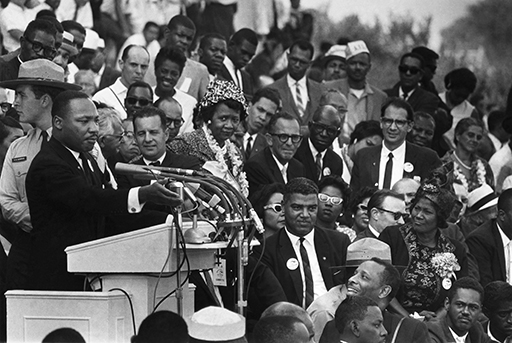1.1 What do leaders care about?
‘Leadership is a process whereby an individual influences a group of individuals to achieve a common goal.’
Leaders often challenge the status quo, trying to take us to new, unfamiliar – possibly even uncomfortable – places. When Martin Luther King stood in front of the crowd in Washington to deliver his now famous ‘I have a dream’ speech, he was already a prominent activist in the American civil rights movement, and he has since gone down in history as one of the men who has shaped modern America (Meacham and Rhodann, 2013). One of the reasons King was so successful was because he had a powerful vision and he energised others to join him. But did you know these words were not in his prepared speech that day? Behind the man and the speech were the words shouted out by his friend, the gospel singer Mahalia Jackson: ‘Tell ‘em about the dream, Martin’ (Jackson, 1963, quoted in Ratcliffe, 2017). Stood just metres away from him, observers have suggested it was her words which prompted King’s passionate digression from his prepared speech to talk about his ‘dream’ (Crockett, 2017).

Following a passion can be central to effective leadership, and King inspired many to do their bit to contribute to making his vision a reality, including Mahalia, who shouted out that day. Another leader with a vision and passion for change is disability rights activist Lady Jane Campbell. When she was born in 1957 with spinal muscular atrophy, doctors gave her a year to live. Inspired by learning about the ‘social model of disability’ as a university student, she became politically active, campaigning for the Disability Discrimination Act 1995, and today she is a noted leader in the disability rights movement. Campbell decided the best way to ensure her vision for legislative change would come from working within the system, and she now sits in the House of Lords.

Martin Luther King and Lady Jane Campbell both show how leadership is fundamentally about creating a vision and engaging others in working towards that vision (Alban-Metcalfe and Alimo-Metcalfe, 2009). They also illustrate how helpful it can be to feel passionate, and really care about the goal you are working towards.
Most organisations will have a ‘vision statement’ and the role of leaders within the organisation is to motivate their team to align themselves with it. Here the vision may not be personal, but it still serves as a core aspect of leadership and organisational success (Vito, 2019). A well-defined and well-communicated organisational vision can enhance motivation and wellbeing, leading to a sense of fulfilment, a reduction in job-related stress and a strong sense of team effectiveness (Strange and Mumford, 2005).
Activity 1 What’s your vision?
Spend a few minutes thinking about where your passions lie and what you really care about. This could be in your work role or your personal life. Has this ever translated into you leading others towards a vision, either formally or informally? Would you like to develop your leadership around this vision?
Make brief notes here to record your thoughts. You will return to this in more detail later.
The essence of leadership, therefore, is often seen as having the ability to create vision, inspiration and momentum in a group of people (Landsberg, 2002). But what sort of person is required for that and how do they set about it?
